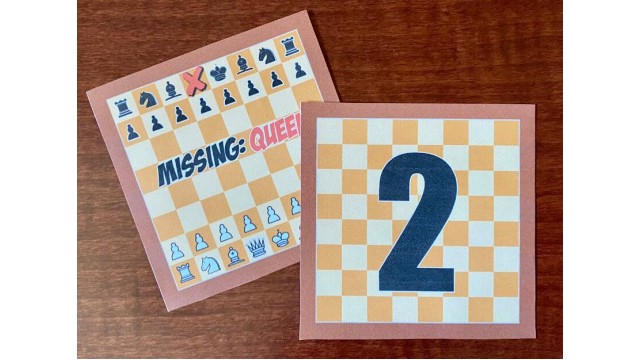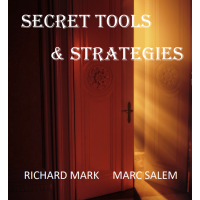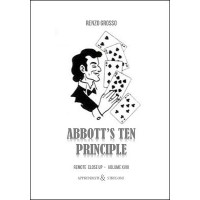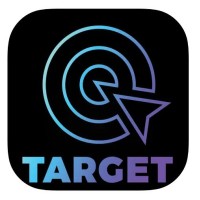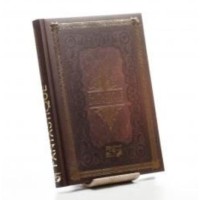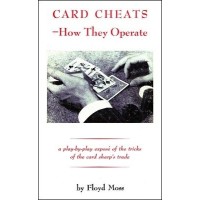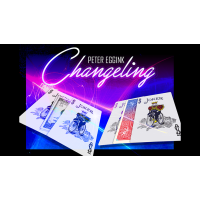Coincidence At Play by Jay Jennings
- Product Code: I2062
- Reward Points: 10
- Availability: In Stock
- $5.99
-
$2.99
- Price in reward points: 299
Perfect as a “synchronicity” routine for couples.
Chess has been going strong for about 1,500 years and is going through kind of a "fad" phase right now (the Netflix series The Queen's Gambit, etc.) so there's never been a better time to introduce a chess-themed routine into your act.
(And even after the fad fades, whenever that will be, the game of chess is still such a big part of most cultures that the routine will continue to feel relevant to audiences.)
Coincidence At Play is a close-up effect, but "plays big enough" that it could easily be used in a parlor-type situation. I made a couple changes to the props and it's perfect for that -- and I give you the way to make those changes yourself, too.
The download PDF version of Coincidence At Play (25+ pages) has everything you need to get started:
The Method
The Preparation
The Presentation and Script
Miscellaneous Notes
Resources
Tutorial Videos
And it includes a "Print Your Own Props" section that allows you to make the needed props on your own printer (or the quick print place down the street).
Print the chess boards on regular paper, print the chess piece cards on thicker paper or Avery business card blanks (it's all set up for that), glue the numbers on poker chips or similar, and you're good to go.
I've even included larger chess boards to print in case you want to go for a parlor-style version.
Coincidence At Play is a fun routine to perform and fun and mystifying for your audience. While not technically a mentalism piece, it can easily be used as a way to get to the subject of mental powers, intuition, etc.
I wouldn't exactly call it self-working, but there's no sleight of hand required to perform and no "gimmicks" to go haywire, so you can focus on the presentation. That's the way I like my routines. -- Jay Jennings
Reviews (0)
Related Products
All Seeing Eye by Dan Harlan
All Seeing Eye by Dan Harlandemo:http://www.penguinmagic.com/p/7311The All Seeing Eye (ASE) by Dan H..
$2.99 $5.99
Chess Guess by Chris Ramsay
The 'Guess Which Hand' effect was popularized in 'Modern Coin Magic' in 1952.Ever since it has becom..
$2.99 $5.99
V2 by Manos Kartsakis
Manos Kartsakis - V2WATCH DEMO #2 FOR AN INTERACTIVE DEMONSTRATION"Fooled me BADLY" -Paul Brook"The ..
$3.99 $22.51
Printable Four Outs by Blake Vogt
Now you can make your own gimmicks! This download comes with a printable PDF file so you can print y..
$0.99 $5.99
Tackling Terrifying Taboos 1 by Jamie Daws
This was Jamies first TTT course which aired in 2017. You can instantly download and this course tod..
$1.99 $5.99
Tackling Terrifying Taboos 3 (1-2) by Jamie Daws
In 1994, a strange occurrence in Mooresville, Alabama, left police offers dumbfounded and left the r..
$1.99 $5.99
Tackling Terrifying Taboos 4 The Year Of The Ouija with Jamie Daws
This year, YOU are part of the experience...For the first time in Taboos history, you are going to g..
$1.99 $5.99
Chess Club by Magic Encarta
LIMITED EDITION: Only 2000 decks printed! Will NOT be reprinted.Chess Club Playing Cards featur..
$3.99 $6.99
$185 Challenge (Video+Templete) by Mike Powers
Give your audience a chance to win up to $100 of your money in a super fair board game. They make al..
$1.99 $5.99
Gambit by Tony Anverdi
Anverdi's Gambit is a perfect add-on for Anverdi's Mental Dice Set.Anverdi's Gambit is 4 beautiful c..
$1.99 $5.99
Jay Jennings – Mind on the Rocks (official PDF)
The mentalist shows cards representing five drinking establishments, each showing their signature dr..
$3.99 $25.00
Recommend
Secret Tools & Strategies by Richard Mark & Mark Salem
Secret Tools & Strategies by Richard Mark & Mark Salem..
$16.99 $80.00
Easy Touch by Ian Baxter
Paul Curry is a name that captures the attention of magicians everywhere, thanks to his famous card ..
$1.99 $8.00
Remote Close Up 18: Abbott'S Ten Principle by Renzo Grosso
THE ABBOTT'S TEN PRINCIPLE: The principle, generally called Abbott's Ten by the Americans, actually ..
$3.99 $14.00
Card Thru Card by Aurélio Ferreira
A perfect solid through solid illusion!Two cards pass through each other.Looks like real magic. Try ..
$1.99 $10.00
Target (Explanation Only)(Video+Pdf) by Sebastien Macak
Take a photo of five items.Put the phone face down.Then ask someone to choose one of the items.Flip ..
$0.99 $26.00
Fantastique (Français) by Antoine Salembier
Il nous aura fallu près de 5 ans pour finaliser ce projet d'envergure ! Ce coffret, c'est ..
$18.99 $191.00
Portal by Peter Eggink & Armanujjaman Abir
Magic done with ordinary objects is still the best magic one can do.Back in 2018 Armanujjaman Abir s..
$2.99 $77.00
Card Cheats: How They Operate by Floyd Moss
A play-by-play exposé of the tricks of the card sharp's trade.Moss gives general advice on how to av..
$4.99 $17.00
Further Tricks Without Names by Werner Miller
Minor math-based tricks and procedural surprises.Enjoy another free sample of Werner Miller's creati..
$0.00 $2.01
Ultimate Bowling Ball From Briefcase by Richard Griffin
EFFECT:A briefcase is opened and shown to be empty. It's then closed, turned upside down, opened aga..
$1.99 $272.90
Im Fokus Nr. 17: Ferrofluid by Christian Scherer
Eine neuartige, kommerzielle Kartenroutine zum Thema 'ehrgeizige Karte' mit einem unpräparierten Kar..
$2.99 $11.95
Smoke Pad by Wang Ji & Bacon Magic
The Smoke Pad balances size and portability, you can spread a full deck of cards on it. It..
$2.99 $401.95
Overdraft by Paul Fowler
They say crime doesn't pay, but whoever said that didn't own Overdraft.Overdraft is a set ..
$1.99 $51.95
Changeling by Peter Eggink
"Changeling" by Peter EgginkA super visual, hands-off card change.A card is selected (signed) by the..
$1.99 $39.50

